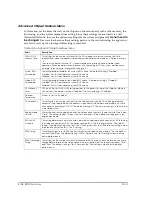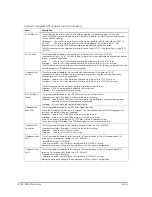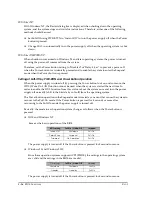
5-10
BIOS Functions
Rev. I
Advanced Chipset Features Menu
In this menu, set the items that rely on the chipset on the main board, such as the memory, the
bus timing, and the system temperature setting. Since these settings are executed via Load
Optimized Defaults, they are the optimum settings for the system and generally
do not need to
be changed
. Be aware that because these settings pertain to the control timing, the apparatus
may fail to start up if an incompatible setting is executed.
Table A-4 Advanced Chipset Features menu
Items
Description
SDRAM CAS
Latency Time
This setting sets the number of clocks for the CAS waiting time for the memory (the time
required from when the address is specified until the data can be read out). Default setting is
“3”.
The use of the default value of "3" is recommended in order to achieve a stable system
operation. Although performance improves with the setting of "2," the system may become
unstable. In such a case, change the setting to "3."
System BIOS
Cacheable
This setting enables/disables the System BIOS cache. The default setting is "Disabled".
Disabled: Set this to disable the system BIOS cache.
Enabled: Set this to enable the system BIOS cache.
Video BIOS
Cacheable
This setting enables/disables the Video BIOS cache. The default setting is "Disabled".
Disabled: Set this to disable the system BIOS cache.
Enabled: Set this to enable the system BIOS cache.
CPU Latency
Timer
CPU and Chip set (GMCH: this setting pertains to the access timing for the Graphics Memory
Control Hub). The default setting is "Disabled". The normal setting is "Disabled".
Delayed
Transaction
Always set this to “Enabled“.
CAS# Latency
This setting sets the number of clocks for the video cache memory CAS waiting period (the
amount of time required after the address is specified until the data can be read out). There
are 2 options, a setting of "2" or "3". The default setting is "3". The normal setting is "3" to ensure a
more stable system.
Paging Mode
Control
This setting controls the page mode for the video cache memory. The options are "Open" and
"Close". The default setting is "Open". The normal setting is "Open" because it operates in the
page open mode.
RAS-to-CAS
Override
This setting determines how much time is required until performing the transfer to CAS following
the video cache memory RAS. The options are the "by CAS# LT setting and the "Override(2)"
setting. The default setting is the "by CAS# LT setting. Normally, the CAS# Latency setting is used
to automatically set the "by CAS# LT" setting.
RAS# Timing
This setting is used to set the RAS access timing for the video cache memory. The two options
are "Fast" and "Slow". The default setting is "Fast". Normally, the "Fast" setting is used to ensure
better performance.
RAS# Precharge
Timing
This setting sets the number of clocks to allocate to RAS in order to accumulate the necessary
charge before refresh of the video cache memory is performed. There are two options, "Fast"
and "Slow". The default setting is "Fast". Normally, the "Fast" setting is used to ensure better
performance.
Содержание DM-M820
Страница 1: ...Technical Reference Manual MR Series English 403308709 Rev I EPSON ...
Страница 2: ......
Страница 20: ...xviii Rev I ...
Страница 42: ...2 8 Setup for the IM 800 and the DM M820 Rev I ...
Страница 50: ...3 8 Hardware Specifications Rev I ...
Страница 178: ...5 38 BIOS Functions Rev I ...
Страница 216: ...8 26 Troubleshooting Rev I ...
Страница 270: ...9 54 Disassembly and Assembly Rev I 6 Remove the HDD cable 216 from the Main circuit board HDD cable ...
Страница 323: ......
Страница 324: ...SEIKO EPSON CORPORATION EPSON ...










































